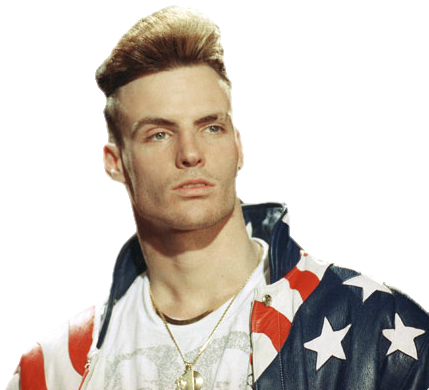 | Ice Ice BabyVanilla Ice |
Writer(s): David Bowie, Queen, Earthquake, Vanilla Ice (see lyrics here) Released: August 22, 1990 First Charted: September 8, 1990 Peak: 12 US, 12 CB, 3 GR, 12 RR, 6 RB, 14 UK, 11 CN, 13 AU, 5 DF (Click for codes to charts.) Sales (in millions): 1.5 US, 0.6 UK, 3.12 world (includes US + UK) Airplay/Streaming (in millions): -- radio, 453.84 video, 366.85 streaming |
Awards:Click on award for more details. |
About the Song:“The success of ‘Ice Ice Baby’ is a crucial pivot-point in the history of rap music.” SG The beginning of hip-hop can be traced back to 1973 when a Jamaican-born teenage DJ known as Kool Herc “played records at a back-to-school party in the rec room of his Bronx apartment building, cutting between the percussive breaks of funk singles and accidentally birthing a whole genre.” SG Six years later, rap hit the mainstream when the Sugarhill Gang hit the top 40 with “Rapper’s Delight,” “In which they rapped europhric rhymes…over the groove from Chic’s disco hit ‘Good Times.’” SG It would be another 11 years before the genre would score its first #1 on the Billboard Hot 100. The genre had largely been viewed as an underground movement among the Black community and a fad. However, after Run-DMC took their remake of Aerosmith’s “Walk This Way” to the top 10 in 1986, rap infilitrated the charts more and more. In the late ‘80s, there were pop songs which integrated rap, but it wasn’t until the fall of 1990 and “Ice Ice Baby” that a full-fledged rap song ascended to the throne. The Dallas-born Robert Van Winkle (aka “Vanilla Ice”) was attacked for being a white kid from the suburbs who was hijacking a largely urban Black musical form. He also received flack for the “hyper-obvious sample of a rock-radio standby,” SG the “spacey, tingling bassline” SG from 1981’s “Under Pressure” by Queen and David Bowie. While sampling had been a norm in hip-hop, the success of “Ice Ice Baby” sparked record companies and artists to demand credit and compensation, making it too expensive for many rap producers to continued sampling as they had before. The song didn’t just borrow from “Under Pressure.” Its hook was lifted from a chant used for years by Black fraternity Alpha Phi Alpha that director Spike Lee used in his 1988 musical School Daze. Others claimed to have written the beat and much of the “memorably ridiculous song” SG with its irrestible hooks and absurdly nonsensical lyrics. Vanilla Ice “sounds clumsily enthusiastic, like he’s trying to project cool reserve even though he can barely believe that he’s getting a chance to rap on record.” SG Vanilla Ice fell in love with hip-hop via the 1984 movie Breakin’. In 1987, he won a talent contest at the Dallas nightclub City Lights, where he was a regular and usually the only white face in the crowd. He became a house act opening for headliners like Paula Abdul, Public Enemy, and Tone Loc. FB The club’s DJ Earthquake produced some songs for Ice which were released by Tommy Quon, the club owner. A reworked version of Wild Cherry’s 1976 hit “Play That Funky Music” was released as a single. It flopped, but Darrel J, a disc jockey at WAGH in Columbus, Georgia, started playing the B-side, “Ice Ice Baby.” FB It took off at radio and a video was made which started getting played on cable networks The Box and BET. Ice signed to a major label who repackaged his 1989 indie-label debut Hooked as To the Extreme and rushed “Ice Ice Baby” to the national market. Resources:
Related Links:First posted 10/17/2022; last updated 6/18/2023. |








No comments:
Post a Comment